That’s Life: Roe v. Wade Opponents March and Bask, Dreamers Worry
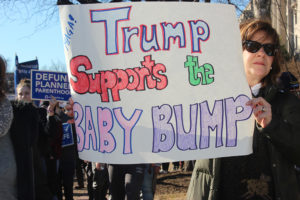 In addition to carrying signs that praised Trump, many marchers wore “Make America Great Again” hats and accessories.
In addition to carrying signs that praised Trump, many marchers wore “Make America Great Again” hats and accessories. Photos by Rachael Berman
Karen Docksey sat against a concrete planter along Constitution Avenue soaking up the sun on a glorious January day. “It’s a joyous occasion,” she beamed. Docksey had flown to Washington, DC, that morning, January 19, from her home in Minnesota to attend the 45th annual March for Life, a gathering of anti-choice activists held each year since Roe v. Wade legalized abortion in 1973. She’s been to the march before, often with a group, but came alone this time and was planning to attend the Women’s March the next day. She wore a beaded cross necklace around her neck and carried a bright pink sign that simply stated: “I Believe in God.”
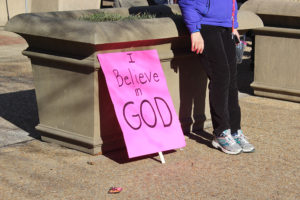 When asked if she felt that Donald Trump was the right president to lead the cause she was unequivocal in her support. “He’s got a flame for life,” she said, also calling him “true” and “genuine.” The Trump administration certainly has given the pro-life movement positive signs. One day prior to the March for Life, for example, the Health and Human Services announced its new Conscience and Religious Freedom Division to handle complaints from medical workers who object to performing or assisting with certain procedures that violate their religious beliefs—namely abortion or assisted suicide. (Many worry such protections will be used to allow medical professionals to discriminate against those whose sexual orientation goes against those beliefs.)
When asked if she felt that Donald Trump was the right president to lead the cause she was unequivocal in her support. “He’s got a flame for life,” she said, also calling him “true” and “genuine.” The Trump administration certainly has given the pro-life movement positive signs. One day prior to the March for Life, for example, the Health and Human Services announced its new Conscience and Religious Freedom Division to handle complaints from medical workers who object to performing or assisting with certain procedures that violate their religious beliefs—namely abortion or assisted suicide. (Many worry such protections will be used to allow medical professionals to discriminate against those whose sexual orientation goes against those beliefs.)
I asked Docksey if the dreamers, whose fate was hanging in the balance on nearby Capitol Hill, were part of a pro-life consideration. “I’m for dreamers staying,” she said. “It’s what God would want.” As we rejoined the march (I was accompanied by AHA Grassroots Coordinator Rachael Berman) Docksey smiled and said, “I’ll see you tomorrow!” And yes, she said she was planning on bringing the same sign.
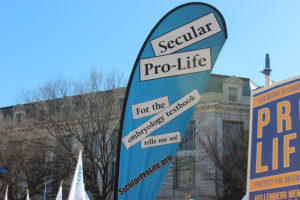 No doubt the majority of people who attend the March for Life are religious and are motivated by conservative Christian values. But venturing down the march route to chants of “Hey, hey! Ho, Ho! Roe v. Wade has got to go!” we spotted a tall banner for the group Secular Pro-Life and made our way over. We spoke with Kelsey Hazzard, a Florida attorney and the president of Secular Pro-Life, a group that says abortion isn’t a culture war issue or a religious issue but a human rights issue, considering the developing fetus as a child.
No doubt the majority of people who attend the March for Life are religious and are motivated by conservative Christian values. But venturing down the march route to chants of “Hey, hey! Ho, Ho! Roe v. Wade has got to go!” we spotted a tall banner for the group Secular Pro-Life and made our way over. We spoke with Kelsey Hazzard, a Florida attorney and the president of Secular Pro-Life, a group that says abortion isn’t a culture war issue or a religious issue but a human rights issue, considering the developing fetus as a child.
Hazzard was marching with other nonreligious groups, including Rehumanize International, a non-profit organization dedicated to human rights and nonviolence. “We oppose all forms of aggressive violence,” the Rehumanize website states, “including but not limited to: abortion, unjust war, capital punishment, euthanasia, torture, embryonic stem cell research, assisted suicide, abuse, and human trafficking.” While some of those are certainly humanist causes, most humanists would take issue with characterizing death with dignity as aggressive violence. Consistent Life Network was another group championing life beyond the abortion question, opposing poverty, war, racism, and euthanasia as well. Hazzard and her compatriots said they’d been well received by other marchers but that no one had asked them any questions about their position. My question was whether they differed from their pious counterparts on the question of contraception, to which Hazzard affirmed, “yes, we’re definitely pro-contraception.”
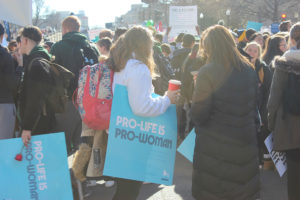
In addition to the sign above, other popular signs included: “Defund Planned Parenthood,” “Pro-Life Voter,” “I Love Storks,” and “Love Life. Choose Life.”
As is often noted, the March for Life brings a sea of Christian high schoolers to DC, often in matching shirts and hats displaying their school logos. The first group of students we encountered were from Bonner & Prendergast Catholic High School outside Philadelphia. Some of the girls stood with an administrator holding signs that said, “Pro-Life Is Pro-Woman.” I asked one of them what she thought it meant. “We’re fighting for a woman’s right to bear children,” she said. I responded that the right to give birth wasn’t in danger. “Well, yeah…” she stammered and then her teacher interjected, “we’re here for life. All life. All life matters.” I asked if that included the lives of dreamers, and the young woman who’d answered my question about the poster said she didn’t know who they were. “We don’t know anything about it,” the teacher affirmed.
Another large group of students in matching spirit wear attended a high school in New York called Kellenberg. (Incidentally, all the students interviewed said their participation was voluntary.) I asked a sixteen-year-old Kellenberg boy if his commitment to the pro-life cause included abstinence until marriage. Taken momentarily by surprise, he said, “that’s a good question,” a grin flashing across his face. “If I’m talking to an adult, yes.”
Perhaps it was the weather—it certainly didn’t hurt to be out walking in brilliant fifty-degree weather after the cold spells we’ve had—but the mood surprised me as ebullient. Some DC police we spoke to said in years when it’s really cold and even snowing, the marchers don’t stop—they move quickly down Constitution Ave. to the Supreme Court. But this had more of a festival atmosphere. While anti-abortion crusaders can be grotesque in their approach (luckily we were spared the gruesome aborted fetus images and videos that were on display elsewhere along the route), the cheerful vibe we encountered seemed bolstered by the fact that the president himself championed their cause, via a live feed from the Rose Garden, and by the youthful energy in the crowd.
As we were leaving the march, we spotted a group of young Hispanic men and women wearing black t-shirts with “DREAMER” stamped in white on the front. We stopped to chat and learned they were all college graduates from Texas who’d been brought to the US illegally as children and had fulfilled all the requirements for DACA status. As members of the League of United Latin American Citizens (LULAC), they’d been in DC for two days meeting with representatives in Congress, including with Texas Senator Ted Cruz’s office.
“They all say they care, but we want them to actually do something to show us they care,” one of the young women said. “People say we broke the rules by coming here, but we’ve done everything right. We’ve gone to school, worked, never been in trouble.” We expressed our deep support (shared by almost 90 percent of Americans) and all wondered, looking at the sea of beaming, mostly white faces marching for life, how the dreamers could conceivably be left out.

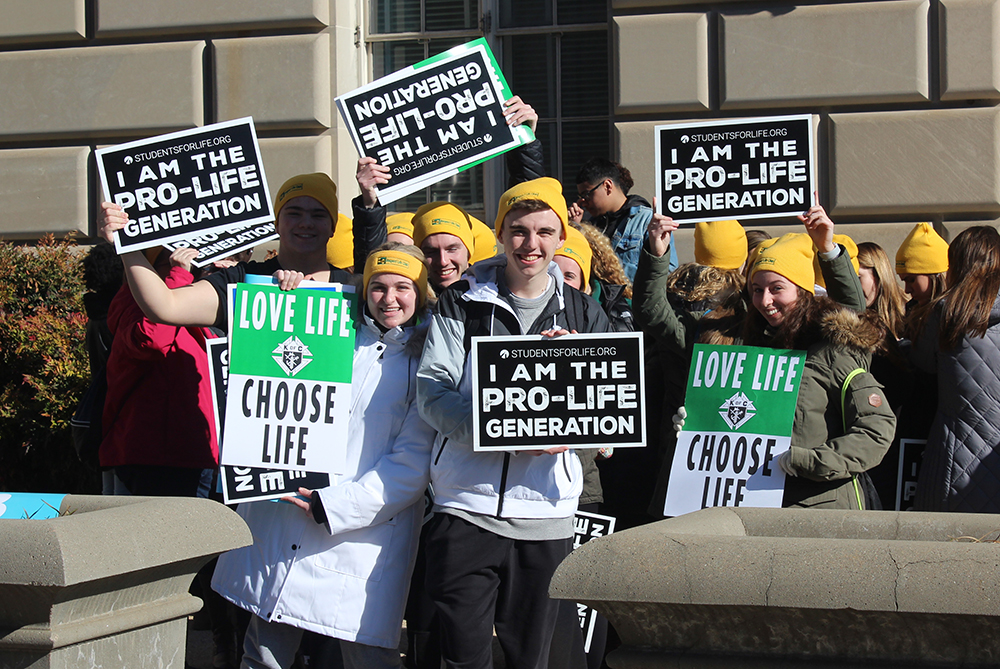
These students are all members of the Respect Life Club at their high school.
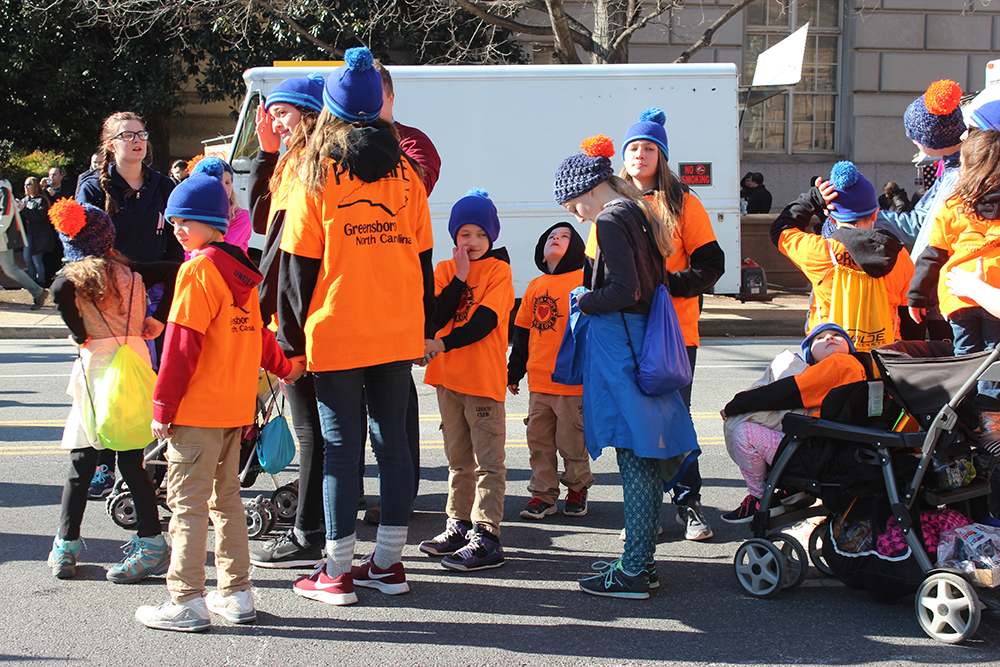
It was quite surprising to see just how many young kids actively participated in the March for Life.


Over one hundred students from Kellenberg Memorial High School in Uniondale, New York, came to the March for Life to “defend life.”
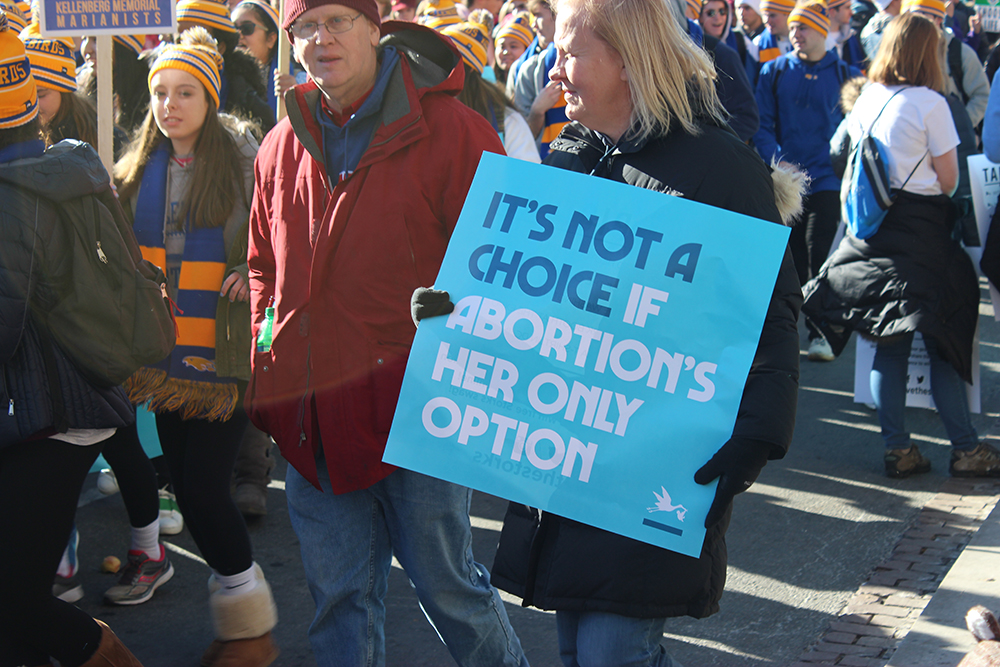
All photos by Rachael Berman
